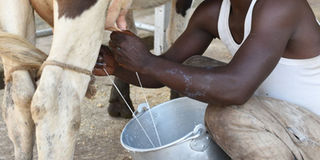Prime
Uganda has a long way to achieve 2020 milk targets

The yield, witnessed a marginal increase to 425 litres after 2012 but later stagnated for three years before declining to 415 litres in 2016. FILE PHOTO
What you need to know:
- Target. According to the Agriculture Sector Strategic Plan 2015/16 - 2019/20, Uganda has a target to produce 3.3m litres of milk by 2020.
Kampala- Dairy farmers have at least five months to produce 1.7b litres of milk if Uganda is to hit its 2020 target
According to the Agriculture Sector Strategic Plan 2015/16 - 2019/20, which set production targets for priority and strategic agricultural commodities, Uganda has a target to produce 3.3b litres of milk in 2020.
However, a report by Economic Research Policy Centre (EPRC) and Ministry of Finance, indicates that Uganda produced 1.6b litres of milk in 2016 leaving a gap of 1.7b litres to close by 2020.
Milk output has nonetheless increased from 1.4b litres in 2002 to 1.6b litres in 2016.
The increase in production is attributed to a surge in milk producing cows and not yield of animals.
“This growth resulted from increased number of milk producing cattle rather than growth in milk yield per cow,” the EPRC report reads in part.
The number of milk producing cows, the report indicates has increased from 1.6m in 2002 to 3.7m in 2016.
However, milk yield per cow has persistently drop from 450 litres per cow in 2002 to 415 litres in 2012.
The yield, witnessed a marginal increase to 425 litres after 2012 but later stagnated for three years before declining to 415 litres in 2016.
According to the report, the findings raise concern that Uganda might not achieve its targets as highlighted in the Agriculture Sector Strategic Plan.
Significant fluctuations in production, the report says, imply unreliability in the required supply of agro- raw materials which inhibits the industrialisation agenda.
Uganda, EPRC says, currently has about 100 dairy firms engaged in manufacturing diversified lines of dairy products with only nine large scale firms whose installed capacity ranges between 65,000 to 800,000 litres per day.
Thirteen medium scale firms have installed capacities ranging between 3000 litres to 24,000 litres a day but with utilization capacity at 3500 litres.
This, the report says is indicative of the room available to absorb more milk from farmers to manufacture high value dairy products with emphasis on powdered milk.
Growing capacity
Brookside Limited, having carried out operational upgrades at its Kampala plant has seen the firm’s processing capacity rise to 300,000 litres.
The firm, however, records a supply shortfall by farmers of 25 per cent propelled by changes in weather.
Mr John Gethi, director of milk procurement and manufacturing Brookside Limited said volumes in dry weather can shrink by close to 70 per cent.
“The firm has been carrying out field days to train farmers on ways of growing milk production through investment in climate resilient practices such as folder conservation,” he said.
In addition, EPRC advised that efforts be geared towards improving yield per cow through breed improvements..



